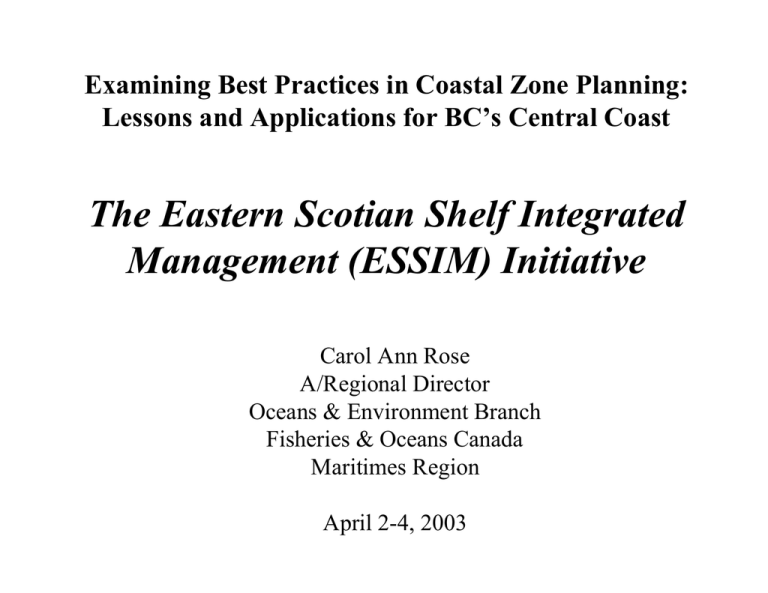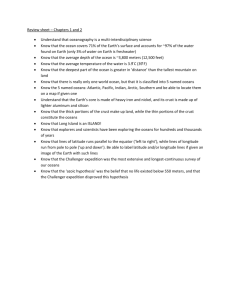The Eastern Scotian Shelf Integrated Management (ESSIM) Initiative
advertisement

Examining Best Practices in Coastal Zone Planning: Lessons and Applications for BC’s Central Coast The Eastern Scotian Shelf Integrated Management (ESSIM) Initiative Carol Ann Rose A/Regional Director Oceans & Environment Branch Fisheries & Oceans Canada Maritimes Region April 2-4, 2003 Outline • Oceans Act and Canada’s Oceans Strategy • The ESSIM Initiative – – – – Background to the LOMA Toward an integrated management plan Developing a collaborative planning process Benefits and next steps • The Bras d’Or Lakes Initiative – Background to the CMA – Working with First Nations – Next steps Canada’s Oceans Act • Set up legal framework – Canada’s Oceans Act enacted in 1997: – legal basis for modern oceans management – based on principles of sustainable development, integrated management and precautionary approach – requires a national oceans management strategy – creates oceans programs Canada’s Oceans Strategy • Developed policy framework – Canada’s Oceans Strategy released July 2002: – sets federal policy framework for modern oceans management – promotes ecosystem-based management philosophy – based on principles of sustainable development, integrated management and precautionary approach What is the ESSIM Initiative? • Announced in December 1998 on recommendation of 1997 Sable Gully Conservation Strategy • Among the first integrated management pilots under the Oceans Act • Applying the National IM Framework at LOMA and CMA scales • Addressing multiple ocean uses and jurisdictions, increasing space competition, conservation issues, and need for an ecosystem approach to management The ESSIM Vision An effective, collaborative process that provides integrated and adaptive management plans, strategies and actions for environmental, social, cultural, economic and institutional sustainability in the Eastern Scotian Shelf Large Ocean Management Area Environmental Institutional Economic Social/Cultural The ESSIM Area Comprises a Large Ocean Management Area (LOMA) Based on mix of ecological, political and ocean use parameters Can be adapted to address management requirements in adjacent areas The ESSIM Process Understanding the area - nature of ocean use and sector activities (Use Audit) - ecosystem understanding and science (Ecosystem Overview) - existing jurisdictional, management and regulatory regimes and processes (Regulatory Overview) Engaging communities of interest Identifying management issues, needs and priorities - multiple ocean use - government and sector dialogue - ecosystem management - proposed ESSIM Forum - management jurisdictions - annual ESSIM Forum Workshops - etc. Multiple Use on the Eastern Scotian Shelf Oil & gas Fisheries Submarine cables Shipping etc….. Toward an Integrated Management Plan The future Eastern Scotian Shelf Ocean Management Plan is proposed as: A multi-year strategic plan for the integrated management of all policies, programs, plans, measures and activities in or affecting the Eastern Scotian Shelf Large Ocean Management Area A Strategic Planning Framework for the Eastern Scotian Shelf Ocean Management Plan (2003 Discussion Paper) Strategic Planning Framework • The 2003 discussion paper describes the key elements of the future Plan – – – – – – – – Definition and legislative basis Vision and guiding principles Area of application Management objectives Ecosystem-based management framework Spatial planning approaches Collaborative planning framework Activities for plan development and implementation Ecosystem-Based Management Framework • The future Plan needs to provide a comprehensive framework for multiple ocean use planning in the context of ecosystem-based management • Ecosystem-based management will be applied at three main geographic scales: – Large Ocean Management Area (LOMA) – Ocean Management Areas (OMA) – Sub-OMAs/Coastal Management Areas (estuarine/inshore) Bras d’Or Lakes Designing a Collaborative Process • The basic elements of the proposed “ESSIM Forum” include: – a “multi-stakeholder” mechanism to provide ongoing communications, information sharing and advice/direction to the planning process – government engagement for operational support and program coordination, and executive-level policy coordination – dedicated administrative and operational support through a Forum Secretariat Plan Development and Implementation • A range of planning requirements have been identified, including: – identification of issues, priorities and timelines for action – development of operational objectives and indicators – further defining the LOMA-OMA-CMA scales – development of collaborative planning process – identification of ecosystem protection approaches, including MPA planning – developing a spatial ocean planning framework, including approaches for balancing use and management objectives Challenges Involved • Linking and working effectively with such a broad and diverse range of interests involves some key challenges: – government coordination (vertical and horizontal) – large number of people involved – time to build relationships and foster trust among (and within) communities of interest – capacity of communities of interest to engage in the broader planning process – willingness of various interests to get involved and accept change – different management scales involved (international through to local) – tendency (and need) to focus on issues and conflict Key Benefits (to date) • The ESSIM process is providing positive results now: – as a vehicle for government coordination and commitment – as a forum for awareness-raising, communications, and issue identification – by developing a collaborative process for multi-stakeholder input, advice and planning – by providing a regional catalyst for ecosystem approaches to oceans management (research & science; improved EA process) Bras d’Or Lakes • 3600 km2 watershed -- 2500 km2 is land and 1100 km2 is water • Lakes play major environmental, economic, and social/cultural roles, including traditional roles for First Nations • Industries: forestry, mining, aquaculture, fishing, agriculture, tourism and recreation (boating, cottage development) • Traditionally considered an inland sea with a mixture of fresh and saltwater • Low flushing times and fresh/saltwater mix create a unique and sensitive aquatic environment First Nations • 30% of population surrounding the Lakes is First Nations • Five First Nations communities around the Lakes • The Unama’ki Institute of Natural Resources (UINR) • New research and management facility at Eskasoni • UINR to develop capacity to undertake planning and management DFO’s Activities in the Bras d’Or Lakes • • • • Fisheries Management: several lake fisheries & IFMPs Science: SIMBOL Program and MOUs with UINR Policy and Economics: NS Sustainable Communities Initiative Oceans and Environment: Community-based habitat restoration and support to projects through various committees • Hydrographic Service: Support to SIMBOL and multibeam data collection • Aquaculture Office: Coordinate site reviews, licences live fish transfers, oyster management committee, & MSX working group • Coast Guard: Support to SCI Projects Planning Efforts • Efforts to plan and manage the Bras d’Or Lakes date to the early 1970s • 1999 Bras d’Or Lakes Ecosystem Workshop • Institutional arrangements will assist in establishing an overall planning process – – – – Unama’ki Institute of Natural Resources Pitupaq Sustainable Communities Initiative Bras d’Or Partnership Committee • Oceans Act and IM Policy Framework • General agreement to pursue Integrated Management Plan for the Bras d’Or Lakes Next Steps for the Bras d’Or • Agreement needed among the many players on a governance framework in the Bras d’Or Lakes • DFO, INAC and EC supporting UINR to hire a coordinator to organize a June 2003 workshop on establishing a governance framework among various groups and interests involved • Coordinator has been hired, a diverse planning team established, the scope of the workshop detailed, and workshop planning is underway • Existing work of DFO within the Bras d’Or will continue





